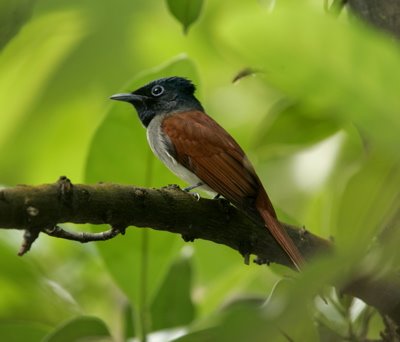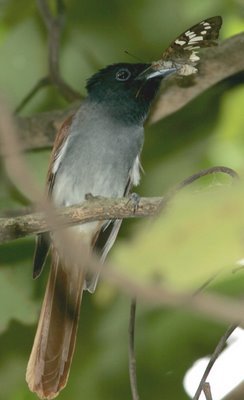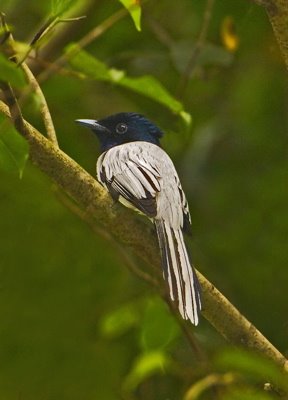Arrival of the Asian Paradise-flycatcher

 Asian Paradise-flycatcher (Terpsiphone paradisi), also known as the Common Paradise Flycatcher, is a migratory bird wintering in tropical Asia. It began to arrive in Singapore around late September and early October and this was the time Meng and Melinda Chan sighted a pair in the Central Catchment forest.
Asian Paradise-flycatcher (Terpsiphone paradisi), also known as the Common Paradise Flycatcher, is a migratory bird wintering in tropical Asia. It began to arrive in Singapore around late September and early October and this was the time Meng and Melinda Chan sighted a pair in the Central Catchment forest.  The male was a white morph with tail longer than the female but the spectacular long central feathers were absent. The pair took turns darting out of the forest canopy to catch flying insects, returning immediately to feed.
The male was a white morph with tail longer than the female but the spectacular long central feathers were absent. The pair took turns darting out of the forest canopy to catch flying insects, returning immediately to feed. It is insectivorous, often hunting for insects like bees, small beetles, flies and neuropterans. It has been reported to hunt with mixed flock. In this instance the female was seen perching near to a Yellow-vented Bulbul (Pycnonotus goiavier).
It is insectivorous, often hunting for insects like bees, small beetles, flies and neuropterans. It has been reported to hunt with mixed flock. In this instance the female was seen perching near to a Yellow-vented Bulbul (Pycnonotus goiavier). Note: On 12th June David Tan sent in images of the bird nesting in Taman Negara, Malaysia. On 28th September KC Tsang reported seeing a juvenile at Sungei Buloh Wetland Reserve. There may be other sightings as well. There is also an earlier posting on its nesting.
Input and images (top, male; rest female) by Meng and Melinda Chan.

The latest addition of the back view image of the bird (left) is by Allan Teo.



5 Comments:
Hi
where was the asian paradise flycatcher spotted in singapore?
regards
Hi
is this the brown phase, I have seen the white phase AP Fly catcher in Thailand.
Do they come over as migrants
Asian Paradise-flycatcher is a migrant. The male has just been uploaded. The rest of the images show the female. The bird can be spotted in parks, gardens and forests. As to specific location, unless the contributor volunteers the information, I do not generally ask.
Hi all,
Just to make a few notes on the Asian Paradise Flycatcher, which happened to be one of my favourite migrant birds. Managed to spot one of these common passage migrants mingling in the yellow flame trees with a large flock of oriental white-eyes and sunbirds at the lawns of the NUS medical blocks.
Asian Paradise Flycatchers are in reality not flycatchers, to begin with, but are closely related to the monarches, philentomas, which in turn are closer to the crows, yes the big bad house crow, and other 'crows' like drongos, orioles, cuckooshrikes etc etc, than to the true flycatchers. Their behavioural and morphological resemblances are hence very likely a result of convergent evolution and similar cological conditions, contrary to molecular data which suggests otherwise. In fact, recent light on dna studies shows that a great deal of our birds in asia are all wrongly classified, famous examples being many of the babblers and warblers.
At a biogeographical level, it would not be apt to say that the asian paradise flycatcher is purely a migrant to tropical asia, as many resident populations actually occur here. As a matter of fact, throughout east and west malaysia (including panti, KL, danum), APF are all year round residents, only to be augmented by migrants in the winter months. Breeding birds range from much of the Indian Subcontinent, kazakhstan, to all of south east asia, throughout the greater sundas, and stretching to eastern Russia in ussuriland (which is actually a large source of our migrants). Northernly populations would migrant to the south, tropical asia, so to speak in winter. Meanwhile, the residents of the tropics are predominatly sedentary.
Some interesting pictures does occur for APF and his khakis. Firstly, it does not occur in Japan and the koreas where it is replaced by the similar Japanese paradise flycatcher. Similarly, Japanese winters mainly in the philippines and not in mainland or sunda south east asia (sumatra, borneo etc).APF winters mainly in tropical asia, but exclude the philippine islands (which interestingly has the most varieties of Paradise flycatchers at 3 species, 2 resident, i migrant). In north borneo, for some reasons, nearly every APF found is a white morph bird...elsewhere in all asia, varying proportions of white and normal morphs can be found..Hopefully someone would shed some light on this still 'grey' area someday...
Ding Li
Hi there I was just checking out your website and I think its very interesting keep up the good work.
Post a Comment
<< Home